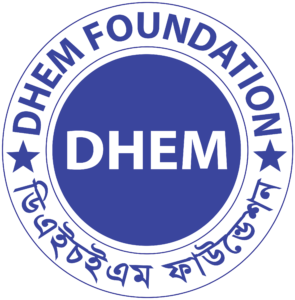Useful Links
Subscribe Now
Don’t miss our future updates! Get Subscribed Today!

The contamination of groundwater by arsenic in Bangladesh is one of the largest poisoning of a population in the history. t is estimated that about 125 million inhabitants of Bangladesh between 35 million and 77 million are at risk of drinking contaminated water.
DHEM has devised a number of effective tools and strategies against this calamity. Here a few of these initiatives have been listed down:
Under this programme, DHEM provides arsenic free safe drinking water to the community members of arsenic affected areas.
DHEM has so far installed 6 River Sand Filters with pipeline system in Sirajdikhan upazila.
The objectives of the programme are:
2.5.2 Piped Water Supply System from River Sand Filter
In collaboration with Dhaka Community Hospital Trust (DCH Trust), DHEM Foundation conducted several surveys on Arsenic contamination. According to these surveys, about 99% tube‐wells were found arsenic contaminated and about 150 arsenic patients in Shushunda village of Muradnagar Upazila and 132 arsenic patients in Joynagar village of Homa Upazila of Comilla district were diagnosed.
After this discovery, DCH implemented some arsenic mitigation, patient management and awareness programmes from its own fund. There were some government mitigations but those were not adequate, and hence DHEM had to manage by themselves.
As a part of this programme DHEM Foundation implemented:
The main objective of these programmes were to supply arsenic, chemical and bacteria free safe water to the community through piped water supply system of River Sand Filter at an affordable cost.
This water could be safely used for drinking and cooking purposes in arsenic affected villages.
More than 10,000 people were directly benefited from this programme.
2.5.3 RAIN WATER HARVESTING ()
One of the easiest ways to save water is to simply collect it, and that’s a practice that is referred to as rainwater harvesting.
Rainwater harvesting is essentially the collection of rainwater in large tanks (like a cistern) that’s then transferred to containers until it’s needed for use. In most cases, the water is used directly from these containers without being purified or filtered.
DHEM Foundation has implemented the RWH programme to provide arsenic‐free safe water to households of the underprivileged people of Ruppur, Kabarikhola, Ratangonj and Jadupur Pabna, Habiganj and Jamtoli Ukhiya Cox’sbazar in collaboration with MERCY Malaysia.
The communities in the mentioned areas have shown a very positive attitude towards seeking and utilizing alternative water options. Instead of using the Arsenic contaminated tube wells, the community has embraced RWH as a viable alternative.
So far, the RWH initiative has shown high level of efficiency in curbing the negative effects of arsenic contamination.
Till date, there is no universally accepted remedy or caregiving regime for Arsenic affected patients. The only known fact is that improved nutrition may help recovery.
In Bangladesh, a lot of patients are suffering from Arsenic Poisoning, but they are not getting any help regarding their treatment.
In this aspect, DHEM Foundation has stepped in to support. They are currently running the following activities:
Facilitating social rehabilitation along with economic and physical rehabilitation.
Don’t miss our future updates! Get Subscribed Today!
©2025. DHEM FOUNDATION. All Rights Reserved.